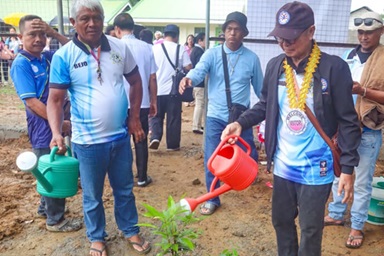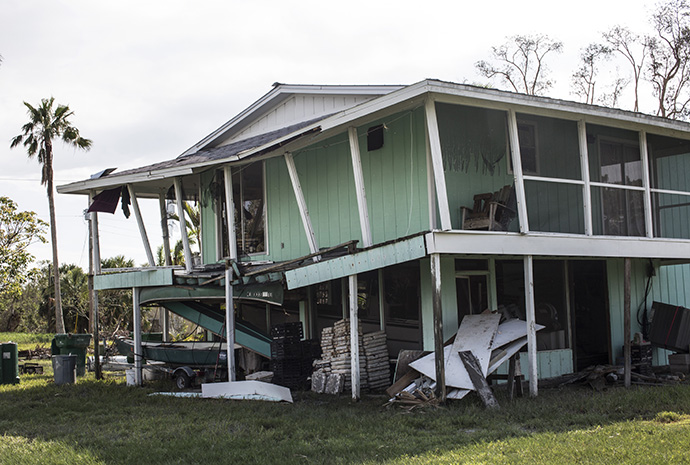
A home in Everglades City, Fla., tilts precariously following damage by Hurricane Irma.
Story by Joey Butler, photos by Kathleen Barry
Sept. 29, 2017 | BONITA SPRINGS, Fla. (UMNS)
For a disaster survivor, it’s this simple: Green is good; orange is bad.
Once urban search-and-rescue teams clear a house, they place a fluorescent sticker in a window. Green means the house is still livable. Orange stickers are for homes that are deemed uninhabitable. The distribution of stickers throughout Bonita Springs is about 50-50.
Many parts of Florida were already deluged with rain from Hurricane Harvey, which struck Texas on Aug. 25, before Hurricane Irma made landfall Sept. 10 at two different locations and spread across the state. The floods that followed Irma provided the knockout punch.
“Basically, we had a flood, a hurricane and a flood,” said the Rev. C.J. Hill, pastor of First United Methodist Church of Bonita Springs.

Debris and damage from Hurricane Irma is visible in this neighborhood street in the village of Goodland, located on the tip of Marco Island, Fla.
As soon as the storm hit, the disaster response team of the Florida Conference sprang into action. The conference spans the length of the peninsula, so just about every district was affected.
Two weeks after the storm, there are still many areas that Pam Garrison and the Rev. Laura Ice have yet to see.
“We will focus where we’ve got churches interested in being involved and also communities that have been overlooked,” said Garrison, the conference’s disaster response coordinator.
“The state and FEMA will focus on higher population areas, so our niche is going into areas where nobody wants to work. But God loves them, too.”
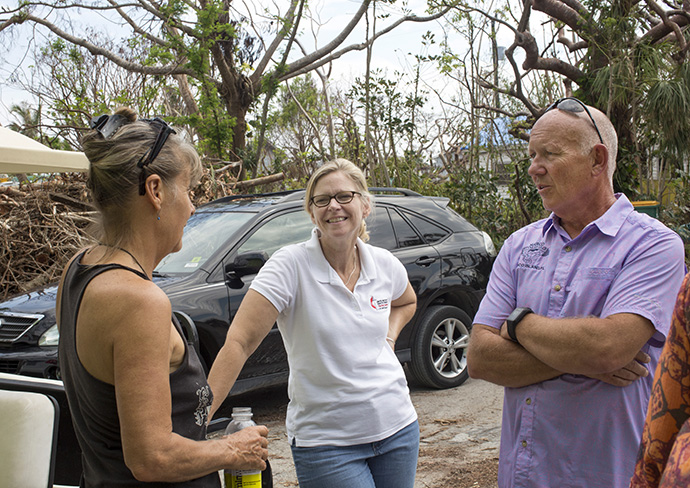
(From left) Denise Santos, the Rev. Laura Ice and Bob Cholka talk outside a Goodland distribution center located on the tip of Marco Island, Fla. Wesley United Methodist Church in Marco Island has reached out to the residents of the Goodland community. Santos is a volunteer from Goodland, Ice is recovery coordinator for the Florida Conference and Cholka is chairperson of the Wesley United Methodist Church council.
Ice, the recovery coordinator, praised the initial church response. “Most of our pastors in impacted areas began immediately to communicate with their congregations and community to find out their needs. Within days we were able to match up churches in areas less affected to begin collecting and delivering goods,” she said.
As an example, Ice cited First United Methodist in Sebring, which began feeding people because the neighborhood had no electricity.
“They said, ‘We have gas, we can cook food, we’re gonna open the doors.’ Other churches responded by sending them food — they didn’t have to buy anything.”

Laurie Diefenthaler volunteers at the community distribution center located in Goodland, Fla. This community was hit hard by Hurricane Irma. Diefenthaler has resided in the community for 17 years.
Garrison and Ice aren’t the only ones keeping the “overlooked” top of mind.
On Marco Island, where Irma made landfall for the second time, the Rev. Kirk Dreiser, pastor of Wesley United Methodist, drove around to assess the area. He didn’t see much structural damage, so he thought the area had avoided the worst.
Then he wondered about Goodland, a small, low-lying fishing village at the end of the island a few miles away.
how to help
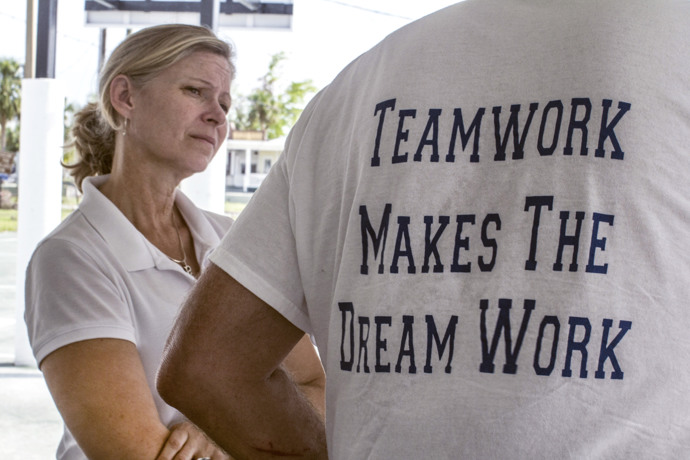
United Methodists wishing to help can make donations directly through UMCOR’s Domestic Disaster Response Advance #901670.
Churches and individuals also can assemble cleaning buckets. Here is how.
Interested in volunteering for Irma recovery? Please register at this link.
Online claim forms and other Irma information.
View more images from United Methodist News Service’s trip to Florida on Flickr.
View our audio slideshow
“No one thought to go to Goodland, and if they had, they’d have crews there for a long time,” Dreiser said. “I happened to be there with a visiting heavy equipment crew and as soon as they saw it, they told me, ‘Preacher, this is where we need to be.’”
The economic dichotomy between affluent Marco Island and tiny Goodland often leaves the small village starving for attention and resources. The few hundred residents of this working-class community of fishermen are proud and self-sufficient. They had already set up a temporary distribution center, and Dreiser began working to have deliveries of food, water and cleaning supplies.
Greg Bello, president of the Goodland Civic Association and self-described “unpaid mayor,” said, “Our residents aren’t used to asking for things, but they’re always happy to give. I tell them, ‘Yes, you can buy water at Publix but these donations are an expression of love. Come take it; that’s what it’s for.’”
“I think Goodland will recover but one of the things they could use is morale boosting,” Bello added. “It’s good for them to know they’re not forgotten.”
Another small town that Garrison and Ice are making sure doesn’t fall through the cracks is Everglades City, population 411.
Jim Ragusa, principal of Everglades City School, is coordinator of the town’s volunteer relief effort. When he starts his truck, the radio comes on full blast.
“Sorry,” he said, reaching for the volume knob. “A little U2 gets me through the day.”
He didn’t look for this job — it found him.
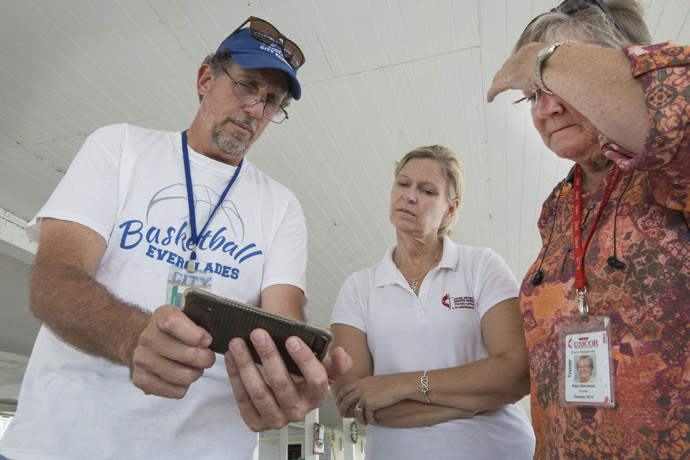
(From left) Jim Ragusa, principal of Everglades City School, shows photos of Hurricane Irma damage to the Rev. Laura Ice and Pam Garrison. Ragusa chose to ride out the storm with other residents. Ice is recovery coordinator for the Florida Conference and Garrison is disaster response coordinator for the Florida Conference.
He rode out Irma in another town, and when he tried to get back into Everglades City two days later, “I saw people just devastated. It’s so painful to see everyone’s lives in their front yard.”
Like the folks at Sebring First, Ragusa had propane on hand and started cooking. One hundred hot dogs turned into 200, then 300. Then Ragusa started asking what people needed. Squeegees, mops, buckets, bins. And he started rounding those supplies up.
“I’ve got some trees down but my house is OK. Those trees will be there. These people are trying to survive. I just figured I can help.”

Debris on this street in Everglades City, Fla., appears to go on forever. The city suffered damage from flooding and high winds from Hurricane Irma.
Assessments are still ongoing, but hopefully the muck-out phase can begin soon. Muck-out will be crucial in Everglades City. Irma unleashed a 10-foot storm surge that swamped the area with contaminated water and sludge. When measuring for contamination, pollution control officers consider 800 units of bacteria per 100 milliliters of sampled water to be toxic. The measurements in Everglades City showed levels of 10,000 units of bacteria.
Garrison is formulating a plan for long-term case management, and Ragusa said he would welcome the church’s case managers to help walk citizens through the process.
“You get so many conflicting stories from insurance,” he said. “You’re told you should throw your stuff out or go ahead and start working on the house. Then you’re told no, wait for the adjuster. People are going to have questions and they need someone they can trust to answer those questions.”

The Rev. C.J. Hill receives a hug from Pam Garrison, Florida conference disaster response coordinator, outside First United Methodist Church in Bonita Springs, Fla. Many of Hill's congregation suffered damage from Hurricane Irma.
Garrison estimates it will be a five-year recovery process for Irma. She and Ice understand the concept of long term: They still have open cases from last year’s hurricanes, Matthew and Hermine. While the assessment phase continues in many areas, the conference is ready to receive volunteers. People can register through the Florida Conference website.
Denise Santos, a 30-year Goodland resident and volunteer at the distribution center, said she’s grateful for all the help The United Methodist Church is providing her community.
“The outpouring from the church has been amazing. Those cleaning buckets are flippin’ awesome!”

Scene from Goodland, Fla., located on the tip of Marco Island, following Hurricane Irma.
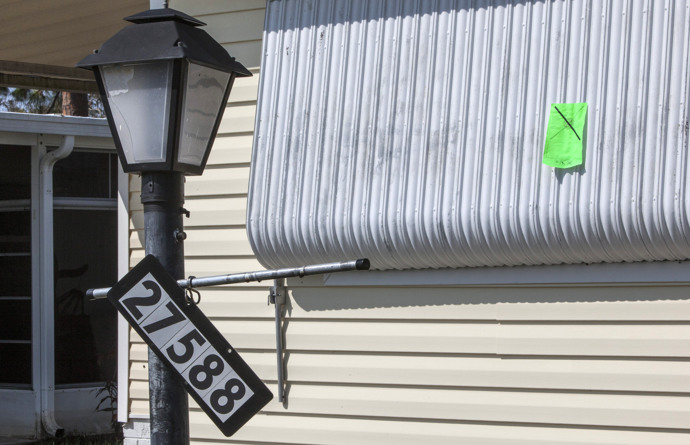
A green sticker on a home Bonita Springs, Fla., signals that this home may be habitable in the future. Homes were marked with various colored stickers indicating degree of damage following Hurricane Irma.
Butler is a multimedia producer/editor and Barry is a photographer and manager of digital assets for United Methodist Communications. News media contact: Vicki Brown, Nashville, Tennessee, 615-742-5470 or [email protected].
To read more United Methodist news, subscribe to the free Daily or Weekly Digests.
Like what you're reading? Support the ministry of UM News! Your support ensures the latest denominational news, dynamic stories and informative articles will continue to connect our global community. Make a tax-deductible donation at ResourceUMC.org/GiveUMCom.

